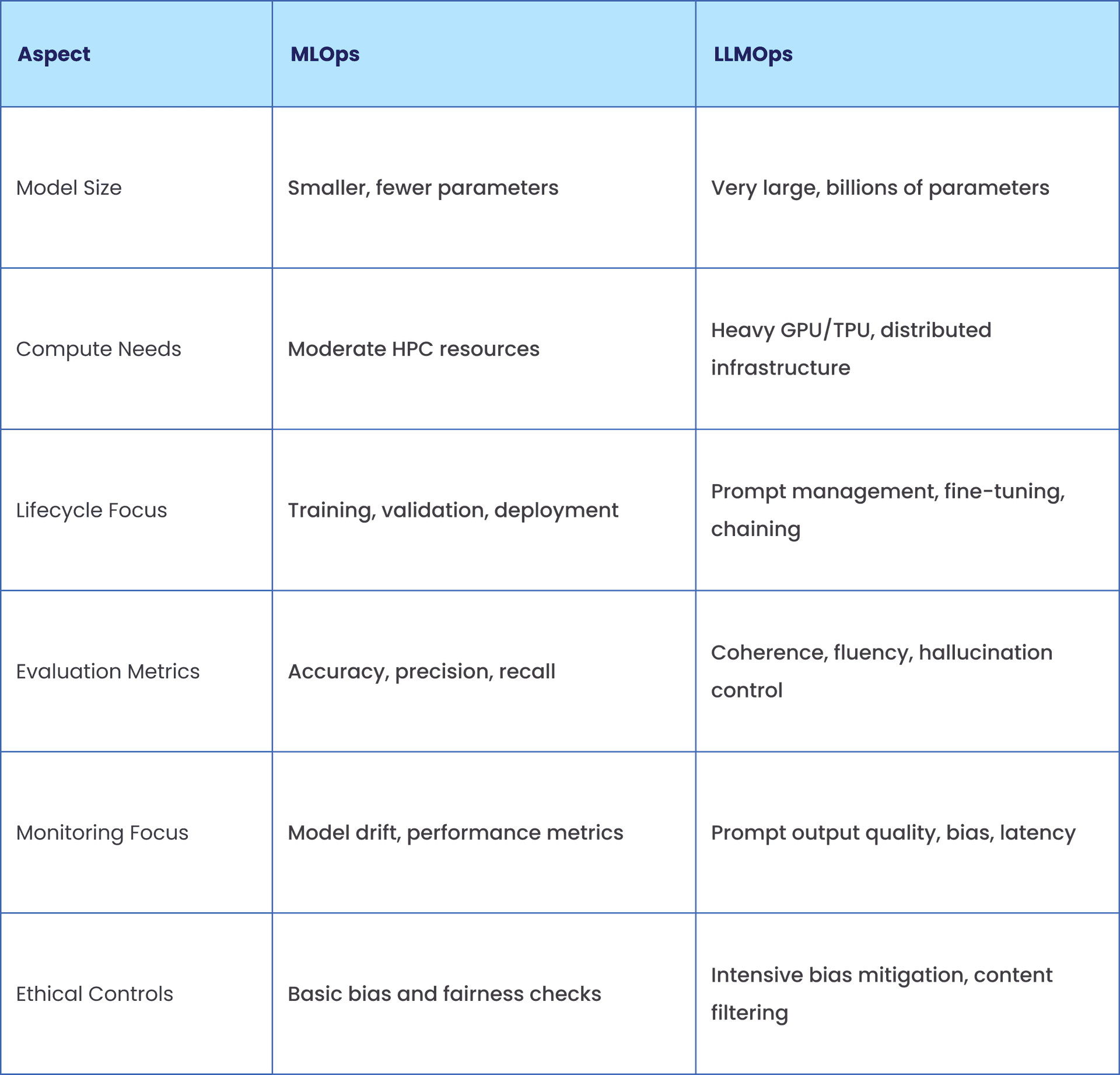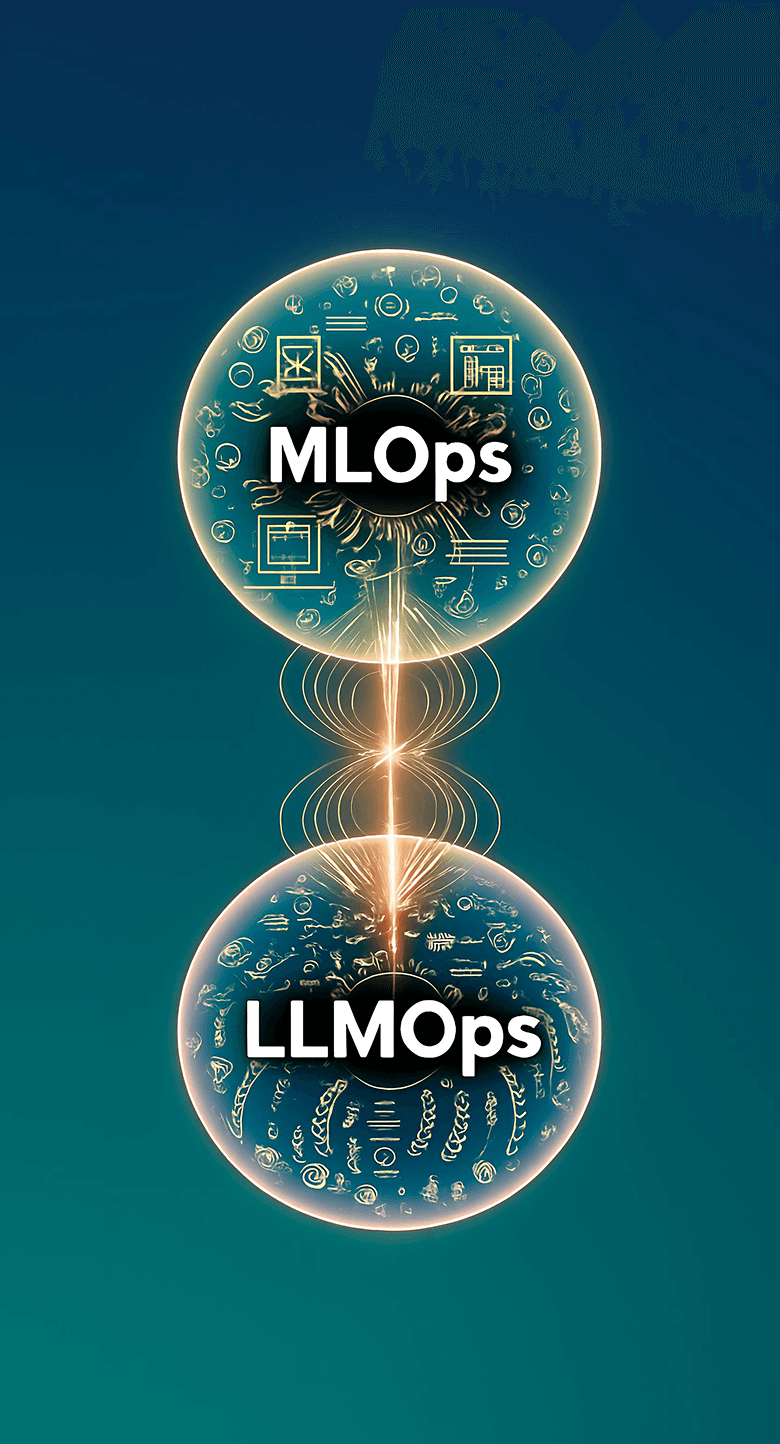


Understanding the evolving AI lifecycle management is key for businesses aiming to harness its full potential responsibly and efficiently. As AI advances, two crucial operational frameworks have emerged: MLOps (Machine Learning Operations) and LLMOps (Large Language Model Operations).
In this blog, we explore what sets these two frameworks apart, their impact on AI projects, and what businesses must know to thrive in the new AI era.
MLOps is a set of practices and tools designed to manage machine learning model lifecycles effectively, from data collection and preprocessing, through model training and deployment, to continuous monitoring and retraining. It bridges development and operations, ensuring models perform reliably in production to drive business decisions.
MLOps typically handles smaller models than today’s LLMs, using tools like MLflow for model tracking, Kubernetes for deployment, and custom monitoring systems for performance and data drift. Its focus is to automate workflows, collaborate across teams, and scale ML applications efficiently within enterprise environments.
LLM operations (LLMOps) are a specialized branch of MLOps designed to meet the unique challenges of Large Language Models, which include billions of parameters and require massive computational resources.
The LLM lifecycle introduces new operational needs beyond MLOps:
Due to their scale, LLMs require costly GPUs or TPUs and distributed computing infrastructure, making resource management central in LLMOps. Moreover, LLMOps emphasizes ethical AI considerations by implementing bias detection, content filtering, and transparency principles more intensively than typical MLOps.

LLMOps extends MLOps by adding new lifecycle stages and tooling tailored to managing complex language generation models, which pose unique risks and opportunities.
Despite differences, LLMOps builds on MLOps foundations:

LLMOps fundamentally reshapes the AI lifecycle beyond traditional MLOps frameworks by introducing unique operational stages and challenges driven by the scale and complexity of Large Language Models.
How have enterprises applied LLMOps workflows and what benefits have they seen?
Cox2M partnered with HatchWorks AI to develop the Kayo AI Assistant using Retrieval Augmented Generation (RAG). This AI assistant enables natural language queries on real-time fleet data for actionable insights such as mileage, hard braking, and routes, boosting operational efficiency and decision speed at scale across cloud platforms like Google Cloud and Vertex AI.
Telecom companies deploy LLMs fine-tuned on domain-specific data to automate tier-1 customer support tasks. These LLMOps pipelines continuously manage prompt tuning, bias detection, and latency monitoring to ensure reliable AI assistance, reduce human agent workload, and enhance customer satisfaction.
Firms utilize LLMOps to generate and audit regulatory documents dynamically with continuous bias and hallucination monitoring. Rapid fine-tuning keeps models aligned with changing regulations, enabling real-time compliance and reducing manual review overhead.
Equip your team with steps to streamline deployment, ensure compliance and unlock the full potential of your large language models.
Ensuring high-quality data is essential for building reliable, fair, and effective AI systems. Poor data quality can lead to inaccurate predictions, biased outcomes, and operational failures. The following five-stage framework outlines best practices for managing data quality throughout the AI lifecycle.
LLMOps is rapidly evolving, with several key trends shaping its future. One of the most critical areas is explainability and interpretability, where tools are being developed to help users understand why an LLM generated a specific output. This is becoming essential for building trust and ensuring regulatory compliance.
Another growing focus is on Green AI initiatives, which aim to reduce the energy consumption and carbon footprint associated with training and deploying large models. In parallel, federated learning and decentralized AI are gaining traction as privacy-preserving techniques that allow model updates across distributed data sources without compromising sensitive information.
The field is also moving toward real-time continuous learning, enabling models to adapt quickly to new data and user feedback without requiring full retraining. Additionally, human-AI collaboration is being enhanced through interfaces that allow experts to guide model behavior and validate outputs more effectively.
Finally, edge deployment is becoming increasingly important, allowing performant LLMs to run on edge devices. This reduces latency and dependency on cloud infrastructure, making AI more accessible and responsive.
To successfully implement LLMOps, organizations should consider the following best practices:
Ethics and governance are foundational to responsible LLMOps. Organizations must define clear policies around data privacy, fairness, and responsible AI use. It’s also essential to establish robust mechanisms for bias detection and content moderation to prevent harmful outputs.
Transparency is key, so implementing audit trails and reporting systems helps ensure accountability. Moreover, fostering ongoing reviews with internal and external stakeholders can proactively identify and mitigate risks, ensuring that AI systems remain aligned with societal and organizational expectations.
The transition from MLOps to LLMOps marks a pivotal evolution in the AI lifecycle, driven by the rise of Large Language Models that demand new operational, infrastructural, and ethical practices. For businesses, adapting to these changes is not just a technical necessity but a strategic imperative to ensure AI solutions are performant, responsible, and cost-effective.
Adopting best practices around prompt engineering, scalable cloud infrastructure, and ethical governance will help organizations harness the transformative power of LLMs while minimizing risks. Enterprises that proactively embrace LLMOps will build trust, accelerate AI innovation, and maintain a competitive edge in the rapidly evolving AI era.

Explore how integrating LLMOps practices can elevate your AI initiatives to meet the demands of 2025 and beyond.

Engineering genius, Adil has a knack for turning complex challenges into seamless solutions. An avid reader and aspiring writer, he dreams of crafting his own captivating stories in the future.
Tomorrow's Tech & Leadership Insights in
Your Inbox

4 Ways AI is Making Inroad in the Transportation Industry

Your Guide to Agentic AI: Technical Architecture and Implementation

5+ Examples of Generative AI in Finance

Knowledge Hub